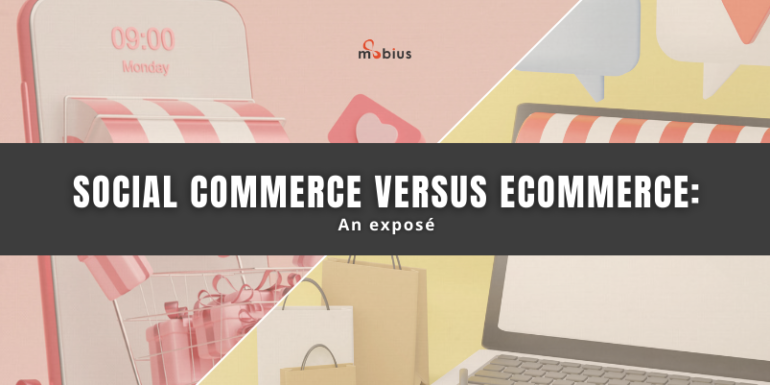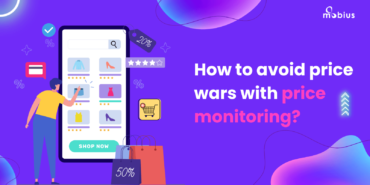Retailers today are burdened with umpteen choices when taking their business online. “Is online selling more effective than traditional selling methods? How does one choose the platforms for online selling? What are the proven ways to reach customers faster? Is social commerce the future of ecommerce?” One is bound to ask these questions.
If you’re one of these retailers trying to understand social commerce, this blog is just for you.
The digital transition has opened up new channels for ecommerce businesses to use social media platforms to increase sales. It has incorporated buying and selling opportunities to assist businesses in creating revenue while fostering a genuine sense of community and connection. Social commerce and ecommerce are often confused as one, as both serve their customers online via similar platforms. But they’re not the same! We will find out more about this in the upcoming sections.
Social commerce is the selling of goods and services to customers directly through social networking platforms. Social media platforms are the best approach to communicating with your customers. You must identify which social media platform works for you and how it may help your company. Social commerce uses interactive features accessible on several social media networks to combine the complete purchasing experience.
How are the two different from each other?
Social commerce and ecommerce are two different things but are often confused as one by businesses and customers. The act of purchasing or selling goods electronically over the Internet is known as ecommerce or electronic commerce. It usually refers to the sale of commodities, but it can also refer to any kind of online business transaction. But, social media and ecommerce intersect in social commerce, which is often described as social shopping. Simply said, social commerce makes transactions through channels directly accessible from businesses’ social media accounts or followers’ feeds.
Ecommerce interactions are undertaken through company websites and other digital platforms like mobile applications. But social networks like Facebook and Instagram are the only places where social commerce transactions occur. The buyer’s process between the two is another important area where these differ. It is often longer in ecommerce because it requires numerous steps. But in the case of social commerce, a transaction is completed in just three or four stages.
When it comes to experience, compared to a conventional eCommerce spree, social media shopping is far more participatory. Customers now easily discuss purchases with their friends, flaunt their new hightops, react to Kendall Jenner’s new outfit, read reviews from other savvy lip color shoppers, and connect directly with the footwear manufacturers they adore. This way, it involves people in the unintentional purchase of products. It is quite common nowadays for people to be easily amused by products online just by looking at someone else’s feed.
Successful retailers vouch for the importance of customer feedback. While customer reviews are easily received in ecommerce, social commerce requires one-on-one conversations or direct messages to get feedback about the product or service. Nevertheless, direct or indirect feedback matters a lot for businesses to grow.
What platforms are offered by social commerce and ecommerce?
While ecommerce platforms offer repetitious means to shop, customers are enthused when personalized, on-time services are provided. Nevertheless, social commerce has its shortcomings. It has the disadvantage of being the less trustworthy platform, while ecommerce platforms are trusted broadly and globally. Social commerce also involves monitoring platforms daily, while ecommerce platforms require a routine but not as often as the former.
The most effective ecommerce platform depends on the distinct business model and expansion strategy. An ecommerce platform is a full-featured software application in which buyers and sellers participate and perform their respective functions. These platforms, such as Shopify, WooCommerce, and Magento, are the ones that online business uses to manage their buying and selling needs. It takes a lot of effort to organize the requirements and design the perfect online store for customers to shop with ease.
An ecommerce marketplace, on the other hand, is a website or app that enables shopping from numerous suppliers. The owner of the marketplace does not possess any inventory. Instead, they are responsible for facilitating transactions and displaying other retailers’ products. Many online markets are available today, including those from Amazon, eBay, Etsy, Walmart, and Alibaba.
What’s important in this process is how the products are given to the customers. You must stay informed of the newest trends if you own a business. Attracting an audience is not possible if your product catalogs are outdated. To help with this obstacle, PIM products like PIMworks, Salsify, and Sales Layer, in the market allow managing product information across various ecommerce platforms, easy integration with top marketplaces, and help all the business needs related to products.
In the case of social commerce, things work differently. Comparative advantages of social media firms impact how they approach social commerce. The main social media networks that assist businesses with social commerce include Facebook, Instagram, Pinterest, and Snapchat.
Facebook and Instagram are the two big platforms implementing amazing social commerce features. While Youtube and TikTok are experimenting with “buy now” buttons, Pinterest is also actively involved, directing users to product-specific pages. Additionally, Twitter is experimenting with a brand-new card design that features a sizable “Shop” button.
Facebook: In addition to Marketplace, which enables all individuals to list regional goods, Facebook offers Facebook Shops for companies to promote their goods and services. Thanks to this fully customizable tool, brands can easily import catalogs from their websites and post them here.
Instagram: Under the Meta banner, Instagram offers Shops where businesses may design a storefront that showcases their goods. They can advertise their services through posts, the “explore” tab, and stories. Following that, users can make purchases within the app using Facebook Pay. Instagram also provides wonderful opportunities for influencers to collaborate with businesses through paid partnerships, barter benefits, giveaways
Despite the differences, how similar are the two?
Not everything is different between the two. Social commerce and ecommerce share certain parallels despite their distinctions. Both practices face similar shortcomings, from credit card fraud to the intangibility of the products during purchase. Another significant similarity in both practices is the need for internet connectivity, without which these platforms become distant.
What is the scope of social commerce in India?
In today’s business era, social commerce has its crown for its myriad of advantages. Over the last few years, it has been established that having a social media presence helps businesses immensely. By 2025 and 2030, social commerce in India is projected to reach USD 16–20 billion and USD 60–70 billion, respectively (source: Grant Thornton), which in reality, looks like it is the future of ecommerce.
The very basic function of social commerce makes business frictionless. It lets customers experience online shopping much faster by lowering friction from product discovery to purchase. You may do this as a brand by minimizing the stages involved in the selling procedure. However, this does not imply that clients will engage with your company less. Social commerce is a practice that increases authentic engagement. Customers are bound to interact with the business at each step of the buying process.
The advent of COVID-19 has caused a domino effect on consumer and retail sentiment, and the “new normal” patterns aren’t going anywhere. Given the numerous logistical difficulties and the nationwide lockdowns, the pandemic created a habit of purchasing things with quicker delivery dates. This encouraged local producers to use social media to their advantage, transitioning from in-person delivery to online ones. Numerous hashtags went viral to support this cause – #VocalForLocall, #ShopLocal, etc.
With the rising internet penetration and social media users in India, social commerce has a higher chance to reach and pull customers than any other selling practice. In comparison, India has over 180 million active Instagram users, higher than the US or Brazil. As seen earlier, Instagram is an excellent platform for businesses today, making it a wholesome advantage for the Indian social commerce industry.
Wrapping up…
Our attention has shifted to social media over time. Initially, social media was used to interact with people, but as the networks developed, people could also do so with businesses. With time, customers began understanding what online stores, social commerce, and ecommerce were all about. Social commerce is the subset of ecommerce and is leading the future of the ecommerce industry. More and more brands will likely be linked to software that promotes cutting-edge technology to satisfy consumer desires. And as far as India is concerned, social commerce shall continue to grow greatly, considering the current market growth of internet users.






